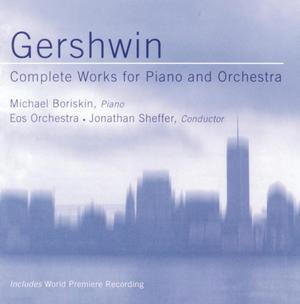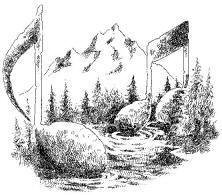|
You are reading the older HTML site
Positive Feedback
ISSUE
50
Gershwin, Complete Works for
Piano and Orchestra
Rhapsody in Blue. Concerto in F for piano and orchestra. Second Rhapsody. Variations on "I Got Rhythm." Michael Boriskin, piano; Eos Orchestra/Jonathan Sheffer. Conifer Classics 75605 51342 2. TT: 74:09 This ten-year-old recording might seem old news. But, given the disappearance of both the Conifer Classics imprint and the Eos Orchestra—the former a victim of industry retrenchment; the latter dissolving, as I understand it, in response to union pressures—it would be a shame if these fine performances were allowed to "fall through the cracks." The Rhapsody in Blue is the unlikely "World Premiere Recording" billed on the front cover—it's played in the "theater orchestra arrangement" by Ferde Grofé, who also scored the original, jazz-band version of the piece for jazz band. I don't have the same problems with the once-standard symphony orchestra arrangement that conductor Jonathan Sheffer does—he finds it "grandiose"—but this small-orchestra edition may be the most effective yet. The reduced forces permit lithe, flexible tempos and light textures, without sacrificing weight and warmth as does the original: the big lyric theme sings out with full-throated soul. (I suppose you could argue that Gershwin didn't expect "weight and warmth"—but, with my ears accustomed to the traditional arrangement, I certainly expect them.) Todd Levy paces the opening clarinet solo nicely, coloring it with a few unscored but effective "blue" bends. Michael Boriskin shades the piano solo with rubato and nuance, exploiting a full dynamic range. His playing is perhaps too thoughtful to be really "jazzy," but his flexibility and structural perception combine the best features of both jazz and classical styles. The Concerto in F was Gershwin's attempt at "serious" concert music, and the opening harmonies and rhythms attempt a suitably sober demeanor, but a cheerful energy can't help intruding and, eventually, taking over. Boriskin inflects his entry phrases with just the right languor, and his flourishes at 4:45 ripple attractively. The orchestra intones the lyric theme at 7:01 tenderly and with some restraint, gradually working it into a grand, expansive climax. The orchestral introduction to the central Adagio movement conveys an overpowering nostalgia that dominates the movement, though the piano's entry picks up the energy; Boriskin again renders the rippling scales at 7:50 with extraordinarily delicacy. The performers infuse the finale's aggressive, driving main theme with a winning buoyancy. The repeated-note theme with which the piano launches the Second Rhapsody suggest that Gershwin is trying to pick up from where the Rhapsody in Blue left off. But the rest of the themes are fresh enough to avoid any suggestion of "sequelitis," with the later work more fluid in design, less conspicuously sectional. A fascinating passage beginning at 7:13 that recalls the earlier Rhapsody's big lyrical tune—but, while the progressions are beautiful and affecting, there's almost no real tune here! Boriskin's estimable pianism struck me as comparatively reticent—I'd have liked a bolder, pingier presence. The clarinet—presumably again Levy, although he's not billed here—introduces the tune of the I Got Rhythm Variations almost tentatively; it's taken up more confidently by other instruments and groups before the piano presents it at full length. Boriskin, Sheffer, and the orchestral players elicit a nice variety from the score. Throughout the program, the Eos players under Sheffer's direction display a fine feeling for the composer's rhythms, knowing when the syncopations should have lightness and "lift," and when they contribute an extra "push." The engineering, from the Recital Hall at SUNY-Purchase, is good enough: focused and dryish, with perhaps a greater hint of hall depth in the concerto than in the rest of the program. This album, then, offers one of the most effective versions of the popular Rhapsody in Blue, makes a plausible case for the Second Rhapsody, and adds stylish renditions of the concerto and the variations, all on a single CD. It's definitely worth seeking out, in the remainder bins or their online equivalents.
|


